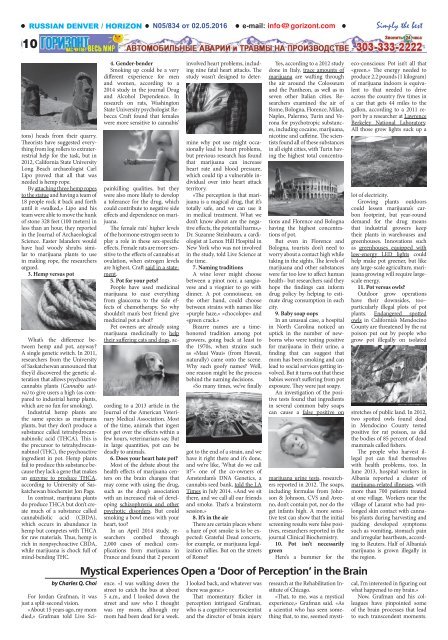Горизонт N6/835
Горизонт (газета) — (Gorizont англ. Horizon ) первая и наиболее влиятельная газета, издающаяся на русском языке в штатеКолорадо, США. Еженедельник, выходит по пятницам, формат Таблоид, 128 цветных и чернобелых страниц, распространяется в городах, составляющих метрополию Денвера (Большой Денвер), и в других населенных пунктах штата Колорадо от графства Саммит до графства Эль—Пасо. Полная электронная версия газеты «Горизонт» доступна в сети Интернет. Подробнее http://en.wikipedia.org/wiki/Gorizont_(newspaper)
Горизонт (газета) — (Gorizont англ. Horizon ) первая и наиболее влиятельная газета, издающаяся на русском языке в штатеКолорадо, США. Еженедельник, выходит по пятницам, формат Таблоид, 128 цветных и чернобелых страниц, распространяется в городах, составляющих метрополию Денвера (Большой Денвер), и в других населенных пунктах штата Колорадо от графства Саммит до графства Эль—Пасо. Полная электронная версия газеты «Горизонт» доступна в сети Интернет. Подробнее http://en.wikipedia.org/wiki/Gorizont_(newspaper)
You also want an ePaper? Increase the reach of your titles
YUMPU automatically turns print PDFs into web optimized ePapers that Google loves.
RUSSIAN DENVER / HORIZON<br />
N05/834 от 02.05.2016 e-mail: info@gorizont.com Simply the best<br />
10<br />
tons) heads from their quarry.<br />
Theorists have suggested everything<br />
from log rollers to extraterrestrial<br />
help for the task, but in<br />
2012, California State University<br />
Long Beach archaeologist Carl<br />
Lipo proved that all that was<br />
needed is hemp rope.<br />
By attaching three hemp ropes<br />
to the statue and having a team of<br />
18 people rock it back and forth<br />
until it «walked,» Lipo and his<br />
team were able to move the hunk<br />
of stone 328 feet (100 meters) in<br />
less than an hour, they reported<br />
in the Journal of Archaeological<br />
Science. Easter Islanders would<br />
have had woody shrubs similar<br />
to marijuana plants to use<br />
in making rope, the researchers<br />
argued.<br />
3. Hemp versus pot<br />
What’s the difference between<br />
hemp and pot, anyway?<br />
A single genetic switch. In 2011,<br />
researchers from the University<br />
of Saskatchewan announced that<br />
they’d discovered the genetic alteration<br />
that allows psychoactive<br />
cannabis plants (Cannabis sativa)<br />
to give users a high (as compared<br />
to industrial hemp plants,<br />
which are no fun for smoking).<br />
Industrial hemp plants are<br />
the same species as marijuana<br />
plants, but they don’t produce a<br />
substance called tetrahydrocannabinolic<br />
acid (THCA). This is<br />
the precursor to tetrahydrocannabinol<br />
(THC), the psychoactive<br />
ingredient in pot. Hemp plants<br />
fail to produce this substance because<br />
they lack a gene that makes<br />
an enzyme to produce THCA,<br />
according to University of Saskatchewan<br />
biochemist Jon Page.<br />
In contrast, marijuana plants<br />
do produce THCA but don’t create<br />
much of a substance called<br />
cannabidiolic acid (CBDA),<br />
which occurs in abundance in<br />
hemp but competes with THCA<br />
for raw materials. Thus, hemp is<br />
rich in nonpsychoactive CBDA,<br />
while marijuana is chock full of<br />
mind-bending THC.<br />
by Charles Q. Choi<br />
4. Gender-bender<br />
Smoking up could be a very<br />
different experience for men<br />
and women, according to a<br />
2014 study in the journal Drug<br />
and Alcohol Dependence. In<br />
research on rats, Washington<br />
State University psychologist Rebecca<br />
Craft found that females<br />
were more sensitive to cannabis’<br />
painkilling qualities, but they<br />
were also more likely to develop<br />
a tolerance for the drug, which<br />
could contribute to negative side<br />
effects and dependence on marijuana.<br />
The female rats’ higher levels<br />
of the hormone estrogen seem to<br />
play a role in these sex-specific<br />
effects. Female rats are more sensitive<br />
to the effects of cannabis at<br />
ovulation, when estrogen levels<br />
are highest, Craft said in a statement.<br />
5. Pot for your pets?<br />
People have used medicinal<br />
marijuana to ease everything<br />
from glaucoma to the side effects<br />
of chemotherapy. So why<br />
shouldn’t man’s best friend give<br />
medicinal pot a shot?<br />
Pet owners are already using<br />
marijuana medicinally to help<br />
their suffering cats and dogs, according<br />
to a 2013 article in the<br />
Journal of the American Veterinary<br />
Medical Association. Most<br />
of the time, animals that ingest<br />
pot get over the effects within a<br />
few hours, veterinarians say. But<br />
in large quantities, pot can be<br />
deadly to animals.<br />
6. Does your heart hate pot?<br />
Most of the debate about the<br />
health effects of marijuana centers<br />
on the brain changes that<br />
may come with using the drug,<br />
such as the drug’s association<br />
with an increased risk of developing<br />
schizophrenia and other<br />
psychotic disorders. But could<br />
smoking a bowl mess with your<br />
heart, too?<br />
In an April 2014 study, researchers<br />
combed through<br />
2,000 cases of medical complications<br />
from marijuana in<br />
France and found that 2 percent<br />
involved heart problems, including<br />
nine fatal heart attacks. The<br />
study wasn’t designed to determine<br />
why pot use might occasionally<br />
lead to heart problems,<br />
but previous research has found<br />
that marijuana can increase<br />
heart rate and blood pressure,<br />
which could tip a vulnerable individual<br />
over into heart attack<br />
territory.<br />
«The perception is that marijuana<br />
is a magical drug, that it’s<br />
totally safe, and we can use it<br />
in medical treatment. What we<br />
don’t know about are the negative<br />
effects, the potential harms,»<br />
Dr. Suzanne Steinbaum, a cardiologist<br />
at Lenox Hill Hospital in<br />
New York who was not involved<br />
in the study, told Live Science at<br />
the time.<br />
7. Naming traditions<br />
A wine lover might choose<br />
between a pinot noir, a sangiovese<br />
and a viognier to go with<br />
dinner. A pot connoisseur, on<br />
the other hand, could choose<br />
between strains with names like<br />
«purple haze,» «chocolope» and<br />
«green crack.»<br />
Bizarre names are a timehonored<br />
tradition among pot<br />
growers, going back at least to<br />
the 1970s, when strains such<br />
as «Maui Waui» (from Hawaii,<br />
naturally) came onto the scene.<br />
Why such goofy names? Well,<br />
one reason might be the process<br />
behind the naming decisions.<br />
«So many times, we’ve finally<br />
got to the end of a strain, and we<br />
have it right there and it’s done,<br />
and we’re like, ‘What do we call<br />
it?’» one of the co-owners of<br />
Amsterdam’s DNA Genetics, a<br />
cannabis seed bank, told the LA<br />
Times in July 2014. «And we sit<br />
there, and we call all our friends<br />
and smoke. That’s a brainstorm<br />
session.»<br />
8. It’s in the air<br />
There are certain places where<br />
a haze of pot smoke is to be expected:<br />
Grateful Dead concerts,<br />
for example, or marijuana legalization<br />
rallies. But on the streets<br />
of Rome?<br />
Yes, according to a 2012 study<br />
done in Italy, trace amounts of<br />
marijuana are wafting through<br />
the air around the Colosseum<br />
and the Pantheon, as well as in<br />
seven other Italian cities. Researchers<br />
examined the air of<br />
Rome, Bologna, Florence, Milan,<br />
Naples, Palermo, Turin and Verona<br />
for psychotropic substances,<br />
including cocaine, marijuana,<br />
nicotine and caffeine. The scientists<br />
found all of these substances<br />
in all eight cities, with Turin having<br />
the highest total concentrations<br />
and Florence and Bologna<br />
having the highest concentrations<br />
of pot.<br />
But even in Florence and<br />
Bologna, tourists don’t need to<br />
worry about a contact high while<br />
taking in the sights. The levels of<br />
marijuana and other substances<br />
were far too low to affect human<br />
health– but researchers said they<br />
hope the findings can inform<br />
drug policy by helping to estimate<br />
drug consumption in each<br />
city.<br />
9. Baby soap oops<br />
In an unusual case, a hospital<br />
in North Carolina noticed an<br />
uptick in the number of newborns<br />
who were testing positive<br />
for marijuana in their urine, a<br />
finding that can suggest that<br />
mom has been smoking and can<br />
lead to social services getting involved.<br />
But it turns out that these<br />
babies weren’t suffering from pot<br />
exposure. They were just soapy.<br />
An investigation of the positive<br />
tests found that ingredients<br />
in several common baby soaps<br />
can cause a false positive on<br />
marijuana urine tests, researchers<br />
reported in 2012. The soaps,<br />
including formulas from Johnson<br />
& Johnson, CVS and Aveeno,<br />
don’t contain pot, nor do the<br />
get infants high. A more sensitive<br />
test can show that the initial<br />
screening results were false positives,<br />
researchers reported in the<br />
journal Clinical Biochemistry.<br />
10. Pot isn’t necessarily<br />
green<br />
Here’s a bummer for the<br />
Mystical Experiences Open a ‘Door of Perception’ in the Brain<br />
For Jordan Grafman, it was<br />
just a split-second vision.<br />
«About 15 years ago, my mom<br />
died,» Grafman told Live Science.<br />
«I was walking down the<br />
street to catch the bus at about<br />
5 a.m., and I looked down the<br />
street and saw who I thought<br />
was my mom, although my<br />
mom had been dead for a week.<br />
I looked back, and whatever was<br />
there was gone.»<br />
That momentary flicker in<br />
perception intrigued Grafman,<br />
who is a cognitive neuroscientist<br />
and the director of brain injury<br />
eco-conscious: Pot isn’t all that<br />
«green.» The energy needed to<br />
produce 2.2 pounds (1 kilogram)<br />
of marijuana indoors is equivalent<br />
to that needed to drive<br />
across the country five times in<br />
a car that gets 44 miles to the<br />
gallon, according to a 2011 report<br />
by a researcher at Lawrence<br />
Berkeley National Laboratory.<br />
All those grow lights suck up a<br />
lot of electricity.<br />
Growing plants outdoors<br />
could lessen marijuana’s carbon<br />
footprint, but year-round<br />
demand for the drug means<br />
that industrial growers keep<br />
their plants in warehouses and<br />
greenhouses. Innovations such<br />
as greenhouses equipped with<br />
low-energy LED lights could<br />
help make pot greener, but like<br />
any large-scale agriculture, marijuana<br />
growing will require largescale<br />
energy.<br />
11. Pot versus owls?<br />
Outdoor grow operations<br />
have their downsides, too–<br />
particularly illegal plots of pot<br />
plants. Endangered spotted<br />
owls in California’s Mendocino<br />
County are threatened by the rat<br />
poison put out by people who<br />
grow pot illegally on isolated<br />
stretches of public land. In 2012,<br />
two spotted owls found dead<br />
in Mendocino County tested<br />
positive for rat poison, as did<br />
the bodies of 85 percent of dead<br />
mammals called fishers.<br />
The people who harvest illegal<br />
pot can find themselves<br />
with health problems, too. In<br />
June 2013, hospital workers in<br />
Albania reported a cluster of<br />
marijuana-related illnesses, with<br />
more than 700 patients treated<br />
at one village. Workers near the<br />
village of Lazarat who had prolonged<br />
skin contact with cannabis<br />
plants during harvesting and<br />
packing developed symptoms<br />
such as vomiting, stomach pain<br />
and irregular heartbeats, according<br />
to Reuters. Half of Albania’s<br />
marijuana is grown illegally in<br />
the region.<br />
research at the Rehabilitation Institute<br />
of Chicago.<br />
«That, to me, was a mystical<br />
experience,» Grafman said. «As<br />
a scientist who has seen something<br />
that, to me, seemed mystical,<br />
I’m interested in figuring out<br />
what happened to my brain.»<br />
Now, Grafman and his colleagues<br />
have pinpointed some<br />
of the brain processes that lead<br />
to such transcendent moments.

















